Portuguese India
This article may require copy editing for grammar, style, cohesion, tone, or spelling. (March 2024) |
State of India Estado da Índia (Portuguese) | |||||||||||||||||||||||||||||||
|---|---|---|---|---|---|---|---|---|---|---|---|---|---|---|---|---|---|---|---|---|---|---|---|---|---|---|---|---|---|---|---|
| 1505–1961 | |||||||||||||||||||||||||||||||
| Anthem: Hymno Patriótico (1808–1826) "Patriotic Anthem" Hino da Carta (1826–1911) "Hymn of the Charter" A Portuguesa (1911–1961) "The Portuguese" | |||||||||||||||||||||||||||||||
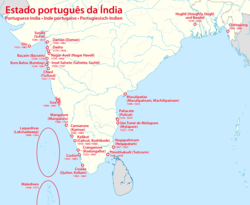 | |||||||||||||||||||||||||||||||
| Status | State of Portugal (1505–1946) Overseas province of Portugal (1946–1961) | ||||||||||||||||||||||||||||||
| Capital | |||||||||||||||||||||||||||||||
| Official language | European Portuguese | ||||||||||||||||||||||||||||||
| Common languages | |||||||||||||||||||||||||||||||
| Religion | Roman Catholicism (official) Hinduism Islam | ||||||||||||||||||||||||||||||
| Monarch and Head of State | |||||||||||||||||||||||||||||||
• 1505–1521 | Manuel I of Portugal | ||||||||||||||||||||||||||||||
• 1958–1961 | Américo Tomás | ||||||||||||||||||||||||||||||
| Governor | |||||||||||||||||||||||||||||||
• 1505–1509 | Francisco de Almeida (first) | ||||||||||||||||||||||||||||||
• 1958–1961 | Manuel António Vassalo e Silva (last) | ||||||||||||||||||||||||||||||
| Historical era | Imperialism | ||||||||||||||||||||||||||||||
• Establishment | 15 August 1505 | ||||||||||||||||||||||||||||||
| 19 December 1961 | |||||||||||||||||||||||||||||||
| Area | |||||||||||||||||||||||||||||||
• Total | 4,305 km2 (1,662 sq mi) | ||||||||||||||||||||||||||||||
| Currency |
| ||||||||||||||||||||||||||||||
| ISO 3166 code | IN | ||||||||||||||||||||||||||||||
| |||||||||||||||||||||||||||||||
| Today part of | |||||||||||||||||||||||||||||||
The State of India (Portuguese: Estado da Índia [ɨʃˈtaðu ðɐ ˈĩdiɐ]), also referred as the Portuguese State of India (Portuguese: Estado Português da India, EPI) or simply Portuguese India (Portuguese: Índia Portuguesa), was a state of the Portuguese Empire founded six years after the discovery of a sea route to the Indian subcontinent by Vasco da Gama, a subject of the Kingdom of Portugal. The capital of Portuguese India served as the governing centre of a string of military forts and trading posts scattered all over the Indian Ocean.
The first viceroy,
Until the 18th century, the viceroy at Goa had authority over all Portuguese possessions in and around the Indian Ocean, from
In later years, Portugal's authority was confined to holdings in the
Context
| Colonial India | ||||||||||||||
|---|---|---|---|---|---|---|---|---|---|---|---|---|---|---|
 | ||||||||||||||
|
||||||||||||||
|
||||||||||||||
|
||||||||||||||
Vasco da Gama lands in India
The first Portuguese encounter with the subcontinent was on 20 May 1498, when
Later Calicut officials temporarily detained Gama's Portuguese agents as security for payment. This annoyed Gama, who carried a few natives and sixteen fishermen with him by force.[7]
Nevertheless, Gama's expedition was successful beyond all reasonable expectations, bringing in cargo worth sixty times the cost of the expedition.
Pedro Álvares Cabral
In 1502, the Portuguese built a trade post in Pulicat because its location at the mouth of a lagoon made it a great natural harbour.[9]
João da Nova
The third Portuguese expedition to reach India sailed under the command of João da Nova and was composed of four ships, tasked mainly with acquiring spices and returning to Europe. While en route, the fleet discovered the islands of Ascension and Saint Helena in the South Atlantic, and despite it having been planned as a purely commercial expedition, the fleet clashed with vessels of the Zamorin of Calicut off the Malabar Coast at the First Battle of Cannanore, the first significant naval battle of Portuguese India.
The fleet may also have called at Ceylon.
Vasco da Gama
Vasco da Gama sailed to India for the second time with 15 ships and 800 men, arriving at Calicut on 30 October 1502. Gama this time made a call to expel all Muslims from Calicut which was turned down. The ruler showed willingness to sign a treaty, but Gama bombarded the city and captured several rice vessels after he was informed that the Zamorin was messaging neighbouring rulers to join him in resisting the Portuguese at the same time.[10] While in India, Gama also attacked Onor, reduced Baticala to tributary status, established a trade treaty and trading post at Cananore, and clashed with a fleet belonging to the Zamorin at the Battle of Calicut of 1503. He returned to Portugal in September 1503.
Afonso de Albuquerque
The expedition of 1503 was the first time Afonso de Albuquerque sailed to India, as its commander. Its activities were limited to erecting a fort on the territory of the allied kingdom of Cochin, signing a peace with Zamorin that would prove brief, and opening a new trading post at Kollam.
Lopo Soares de Albergaria
The sixth Portuguese expedition to India was commanded by Lopo Soares de Albergaria, who bombarded Calicut, relieved Duarte Pacheco Pereira and the Portuguese garrison at Cochin defending the territory from a large attack by the Zamorin at the Battle of Cochin, sacked Cranganore, struck an allegiance with the king of Tanur which removed him from the suzerainty of the Zamorin, and finally captured a large Egyptian trade fleet at the Battle of Pandarane.
Foundation (1505–1515)
Francisco de Almeida
On 25 March 1505,
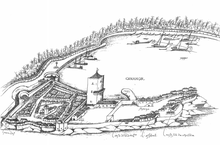
On 13 September, Francisco de Almeida reached Anjadip Island, where he started the construction of

On 31 October 1505, Francisco de Almeida reached
The Zamorin prepared a fleet of 200 ships to oppose the Portuguese, but in March 1506,
In 1507 Almeida's mission was strengthened by the arrival of Tristão da Cunha's squadron. Afonso de Albuquerque's squadron had split from that of Cunha off East Africa and was independently conquering territories in the Persian Gulf to the west.
In March 1508, a Portuguese squadron under the command of Lourenço de Almeida was attacked by a combined
Afonso de Albuquerque
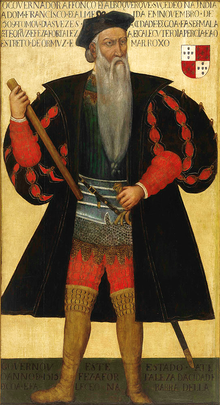
In 1509, Afonso de Albuquerque was appointed the second
In 1510, Afonso de Albuquerque
Albuquerque added to the State of India the cities of Malacca in 1511 and
Albuquerque's policies proved immensely popular amongst his soldiers as well as the local population, especially his characteristically strict observance of justice.[17] When Albuquerque died in sight of Goa in 1515, even the Hindu natives of Goa mourned his passing alongside the Portuguese.[18][19] His tomb at the Nossa Senhora da Serra hermitage was converted to a shrine by the local Hindus, who would leave flowers there in his dedication and direct prayers to him, seeking aid in matters of justice, until his remains were returned to Portugal in 1566.[20]
The Portuguese had also shipped
16th to 17th century

In 1520, the Portuguese extended their dominion over the town of
In 1526, John III of Portugal granted the city of Goa and its town hall the same legal status as Lisbon, in a foral in which the general laws and privileges of the city, its town hall, and the local Hindu community were detailed – especially important since at the time the native laws of Goa were still not written, instead being handled by councils of elders or religious judges and passed down orally.[21]
There were Portuguese settlements in and around the

Several colonies were also acquired from the
The Ottoman Empire carried out the Siege of Diu in 1538, with a strong fleet under the command of the Ottoman governor of Egypt Sulaiman Pasha for four months, with the aid of a large army provided by the Sultan of Guzerat; however they were ultimately forced to retreat with considerable losses. The successful defence of Dio by captain António da Silveira against overwhelming odds was a battle of annihilation, is one of the most celebrated exploits in Portuguese history, and frequently compared to the Great Siege of Malta. On the occasion, the Portuguese captured the Tiro de Diu, a massive Guzerati bombard.

According to Portuguese records, there was a cholera epidemic in 1543, "It is said that deaths from the disposal of the disease were so numerous that the disposal of bodies was a formidable task"[22]
On 16 May 1546, the Jesuit missionary

In 1556, the
By the start of the 17th century, the population of Goa and the surrounding areas was about 250,000.
17th to 20th century
This section needs expansion. You can help by adding to it. (March 2022) |

17th century
The
In 1683, the
Kollam (
18th century
Most of the Northern Province, composed of
In 1752, Mozambique was detached from the State of India and henceforth ruled by its own governor.

In the aftermath of the battles and the losses, the Portuguese expanded the territory of Goa between 1763 and 1788, at the expense of the Dessais of
In 1783, following an attack on the Portuguese ship Santana, the Marathas handed over control of the territories of Dadrá and Nagar Áveli. The Portuguese then purchased Dadrá in 1785. By 1818, the Portuguese were the undisputed rulers of Nagar Áveli after the dissolution of the Maratha Confederacy.
19th century

In 1843, the capital was moved to
Second World War
Portugal was neutral during the Second World War. As a result, at the outbreak of hostilities, Axis ships sought refuge in Goa rather than be sunk or captured by the British Royal Navy. Three German merchant ships, the Ehrenfels, the Drachenfels and the Braunfels, as well as an Italian ship, took refuge in the port of Mormugao. The Ehrenfels began transmitting Allied ship movements to the U-boats operating in the Indian Ocean, an action that was extremely damaging to Allied shipping.
The British Royal Navy was unable to take any official action against these ships because of Goa's stated neutrality. Instead the Indian mission of Special Operations Executive backed a covert raid using members from the Calcutta Light Horse, a part-time unit made up of civilians who were not eligible for normal war service. The Light Horse embarked on an ancient Calcutta riverboat, the Phoebe, and sailed around India to Goa, where they sank the Ehrenfels. The British then sent an unencrypted radio message announcing it was going to seize the territory. This bluff made the other Axis crews scuttle their ships fearing they could be seized by British forces.
The raid was described in the book Boarding Party by James Leasor. Due to the potential political ramifications of the fact that Britain had violated Portuguese neutrality, the raid remained secret until the book was published in 1978.[41] In 1980 the story was made into the film, The Sea Wolves, starring Gregory Peck, David Niven and Roger Moore.
1945 to 1961

On 24 July 1954 an organisation called "The United Front of Goans" took control of the enclave of Dadra. Nagar Haveli was seized by Azad Gomantak Dal on 2 August 1954.[42] The International Court of Justice at The Hague delivered an impasse verdict, regarding access to Dadra and Nagar Haveli by Portugal.[43]
From 1954, the
To facilitate the transport of people and goods to and from the Indian enclaves, the Salazar dictatorship established an airline, Transportes Aéreos da Índia Portuguesa,[49] and airports at Goa, Daman and Diu.
In December 1961, India invaded the remaining Portuguese possessions.[50] Portuguese forces had been given orders to either defeat the invaders or die.[citation needed] The Governor of Portuguese India signed the Instrument of Surrender on 19 December 1961, thus ending 450 years of Portuguese rule in India.[51]
Post-annexation

Status of the new territories
Free Dadra and Nagar Haveli existed as a de facto independent entity from its independence in 1954 until its merger with the Republic of India in 1961.[52]
Following the annexation of
In 1967 a
The most drastic changes in Portuguese India after 1961 were the introduction of democratic elections, as well as the replacement of Portuguese with English as the general language of government and education.
Citizenship
The Citizenship Act of 1955 granted the Government of India the authority to define citizenship in the Indian Union. In exercise of its powers, the government passed the Goa, Daman and Diu (Citizenship) Order, 1962 on 28 March 1962 conferring Indian citizenship on all persons born on or before 20 December 1961 in Goa, Daman, and Diu.[58]
Indo-Portuguese relations

Portugal's
Administration
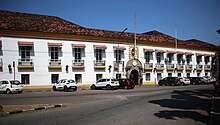
From the establishment of Portuguese India in 1505 until its disestablishment in 1961, an official with the title of governor or viceroy served as its highest authority, usually for a three-year term, initially with authority over all Crown territories east of the Cape of Good Hope. The latter title was attributed as a high honour while the monarchy lasted, however their duties were the same as governors.
The most important administrative structure of the State was put in place in the 16th century; it included the high court (relação), the superintendency of finances (vedoria da fazenda) run by a Crown appointed vedor, financial accounts office (casa dos contos) and the military registry and supply office (casa da matrícula).[65]
The extremely scattered nature of Portuguese holdings however, meant that the State was highly decentralized, with great power being held by individual fortress captains, their captain-generals or town halls, far away from Goa.[66] Like the governors and viceroys, fortress captains served for three years, however their terms could be renovated.[66] Sancho de Vasconcelos, captain-major of Ambon served for 19 years.[66] In the most important captaincies, financial authority rested with the vedor (superintendent), while judicial authority was vested in an ouvidor ("ombundsman").

The Church played an important role in the State. The Pope had granted the Kings of Portugal exclusive ecclesiastical rights to religious patronage (Padroado) in their overseas possessions. After 1513 Portuguese eastern holdings were part of the bishopric of Funchal seated in Madeira island. After 1557 Goa became the seat of an archbishop with subordinate bishops in Cochin and Malacca.[67] Further sees were later opened in Macau in 1576 and in Funai in 1588. Religious Orders of the Augustinians, Franciscans, Dominicans and Jesuits established mission headquarters in Goa, giving the Catholic Church a very visible presence and influence in the capital of the State of India, for which it earned the nickname of "Rome of the East", a fact commented by many foreign travellers.[67]
In the most important settlements featured a câmara ("town hall"), with charters similar to equivalent cities in Portugal, and they played an important role in administration, as they were the only institution through which settlers could voice their opinions and make themselves heard.
Aside from the Portuguese themselves, the State often also ruled over non-Portuguese, non-Christian peoples, and in these cases often the traditional native structures were left in place. When Afonso de Albuquerque captured Goa, the Hindu inhabitants were left in possession of their lands; the pre-Portuguese system of land-ownership and administration of village communes codified and the rights of Brahmin or Khsatria ganvkars (shareholders) recognized, and tax collection was left to the Hindu
Trade and economy
Trade had been one of the primary motivations behind the Portuguese expansion overseas, and one of the main objectives behind the foundation of the State of India was to take over the Europe-Asia trade, up to that point conducted mainly through the Red Sea and the Persian Gulf, redirecting it around Africa via the Cape Route. Trade was processed either by the Crown through royal agents (feitores) working from royal trade posts (feitorias) and maintained by the royal finances, or by independent merchants, either Portuguese or otherwise.
One of the main tasks of royal factors was to acquire spices to be shipped back to Europe. In 1503, the Portuguese unloaded at Lisbon 30,000 quintals of spices, more than what the Venetians introduced in the European marked through Alexandria in Egypt.[70] The overwhelming bulk of commodities imported to Europe by the Portuguese consisted of black pepper, which after 1520 was declared an official Crown monopoly.[71] The Portuguese acquired most of their pepper in Kerala or Kanara in India. For most of the century, the Portuguese secured an overwhelming share of the pepper imports into Europe, supplying 75 per cent or more of Europes pepper.[72] The Crown declared a monopoly on their commodities, such as cloves, nutmeg, mace, cinnamon, ginger, silk, pearls and the export of gold and silver bullion from Portugal to Asia.

The Portuguese Crown instituted a number of official carreiras, literally meaning "runs", connecting Goa to major Portuguese and non-Portuguese harbours around the Indian and Pacific oceans once a year. Initially conducted through Crown vessels, after 1560, the Crown began leasing them to private contractors, and by the late 16th century they were the norm.[74] By 1580, the value of inter-Asian trade rights leases reached as high as two million cruzados - twice the value the Portuguese Crown earned from the Goa-Lisbon trade.[75]
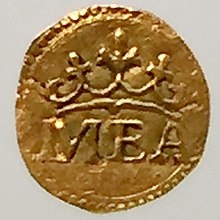
Portugal regulated and rerouted the Indian Ocean trade by imposing a system of safe-passes called cartaz.[76] It was imposed most effectively on the west coast of India.[77] The Portuguese Crown also collected high customs dues, most importantly at Goa, Hormuz, Malacca, Bassein and Diu, and in the 1580s it accounted for over 85% of the viceroys revenue.[78]
Independent Portuguese merchants got involved in the inter-Asian trade, and the backbone of informal Portuguese presence and trade in Asia was formed of
Portuguese India Company was established in 1628, however with the Crown being its only major shareholder, it was liquidated five years later.[85] By that point, Portugal's share of pepper trade had fallen behind those of the Dutch VOC and the English EIC.[86]
Portuguese trade was greatly reduced by
Society and culture
The State was largely urban, since its reason of being was to provide well-protected havens from which trade and communication could be conducted, controlled and dominated, hence only Goa, Daman, Bassein, Chaul and Colombo had any meaningful hinterland and rural populations.[92] After the massacre of the Portuguese in their feitoria in Calicut in 1500, practically every possession of the State was fortified, sometimes massively, and for this reason it resembled as much a network of maritime communications as an enormous perimeter of fortresses.[93]
Portuguese India harboured a society that was officially Christian and European but influenced by the non-European setting into which it was inserted. At the top of the social pyramid were the European-born viceroys, officers, and clergymen, followed by the Portuguese casados and their Eurasian descendants, who could be wealthy merchants or hold important positions in the local câmara, and finally the native society. Portuguese living in Asia or east-Africa were generally more accepting of non-Christian beliefs and practices than their countrymen from Europe or Catholic clergy generally approved.[94] At their peak in 1600, the total number of Portuguese casados across the State probably numbered about 5,500.[95] Many casados followed a lifestyle that seemed to foreign visitors as remarkably relaxed and luxurious by European standards, some living in fine houses furnished in the Indian fashion with many servants, abundant and varied food that included a wide variety of fruits and poultry, consumed off Ming porcelain. Goan casados often dressed in shirts and white trousers while their wives usually wore saris.[96]
Alongside fortresses, ecclesiastical buildings dominated the skyline of most Portuguese settlements, particularly in Goa, giving the city a distinctly European and Catholic flavour and a high profile to the Church.[97] About 600 clergymen were concentrated in Goa out of perhaps 1800 east of the Cape of Good Hope in 1630.[98] Nevertheless, the European and Christian Eurasian community in any Portuguese settlement of the State always constituted a minority, perhaps no more than 7% in the case of Goa, the rest being Hindus, Indian Christians, other Asians and Africans, free or slaves.[99]
For these reasons, the State was culturally hybrid, distant as it was from Europe, with the façades and interiors of churches blending Portuguese and Asian iconographic traditions, while the domestic culture was likewise a compromise between East and West, with furniture, dress and food often more Asian than Portuguese.[100]
Postal history

Early
The last regular issue for Portuguese India was on 25 June 1960, for the 500th anniversary of the death of Prince
Dual franking was tolerated from 22 December 1961 until 4 January 1962. Colonial (Portuguese) postmarks were tolerated until May 1962.
Gallery
-
Indo-Portuguese illustration of a Portuguese nobleman and Christian Indian women, from the Códice Casanatense.
-
16th century Indo-Portuguese illustration of the main deities of Hinduism at the Códice Casanatense.
-
16th century Indo-Portuguese illustration of a Hindu marriage at the Códice Casanatense.
-
16th century Indo-Portuguese illustration of Saint Thomas Christians at the Códice Casanatense.
-
16th century Indo-Portuguese illustration of Kanarese peasants at the Códice Casanatense.
-
18th century Indo-Portuguese cabinet
-
Indo-Portuguese cabinet
-
Indo-Portuguese writing cabinet
-
Indo-Portuguese furniture
-
Indo-Portuguese pistol
-
17th century Indo-Portuguese Christian ivory.
Currency
| ½ Tanga (1903)
| |
|---|---|

| |
| Obverse: Lettering "CARLOS I REI DE PORTUGAL MCMIII", portrait of King Carlos I. | Reverse: Lettering "INDIA PORTUGUEZA ½ TANGA", coat of arms of Portuguese India. |
| 800,000 coins minted, bronze. Engraver Valancio Alves. | |
| 1 Escudo (1959) | |
|---|---|

| |
| Obverse: Lettering "ESTADO·DA·INDIA", face value with Coat of arms of Portuguese India in the center. | Reverse: Lettering "REPÚBLICA · PORTUGUESA", year and Coat of arms of Portugal in the center. |
| 6,000,000 coins minted. This coin was from State of India. | |
-
20 Portuguese bazarucos from 1799, reverse.
-
20 Portuguese bazarucos from 1799, obverse.
-
1866 1/8 tanga.
-
1 Portuguese India rupia, 1882.
-
1947 escudo coin.
-
1959 100 escudos.
-
60 Portuguese India centavos, 1959.
-
1938 5 rupias banknote reverse.
-
1938 5 rupias banknote obverse.
Architecture
-
Indo-Portuguese house
-
Portuguese villa
-
Goa Cathedral
-
The church of Our Lady of the Immaculate Conception in Panaji (Goa, India).
-
Old Goa,Church of Lady of Rosary
-
Bom Jesus Basilica, Goa.
-
House in Goa.
-
House in Goa.
-
Governors palace in Diu.
-
Church of São Paulo in Diu.
See also
| History of South Asia | |
|---|---|
 | |
| (330–323 BC) | |
| Maurya Empire | (321–184 BC) |
| Seleucid India | (312–303 BC) |
| Sangam period | (c. 600 BC – c. 300 AD) |
| Pandya Empire | (c. 300 BC – AD 1345) |
| Chera Kingdom | (c. 300 BC – AD 1102) |
| Chola Empire | (c. 300 BC – AD 1279) |
| Pallava Empire | (c. 250 AD – AD 800) |
| Maha-Megha-Vahana Empire | (c. 250 BC – c. AD 500) |
| Parthian Empire | (247 BC – AD 224) |








































